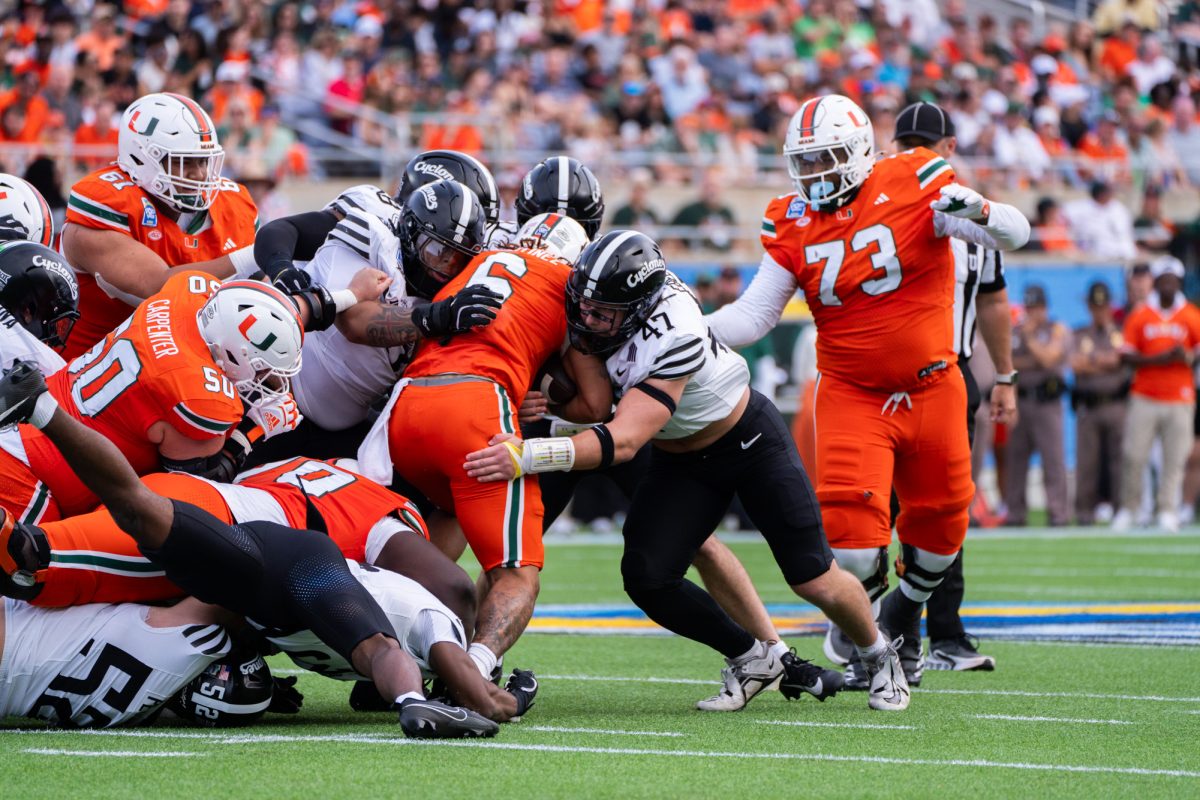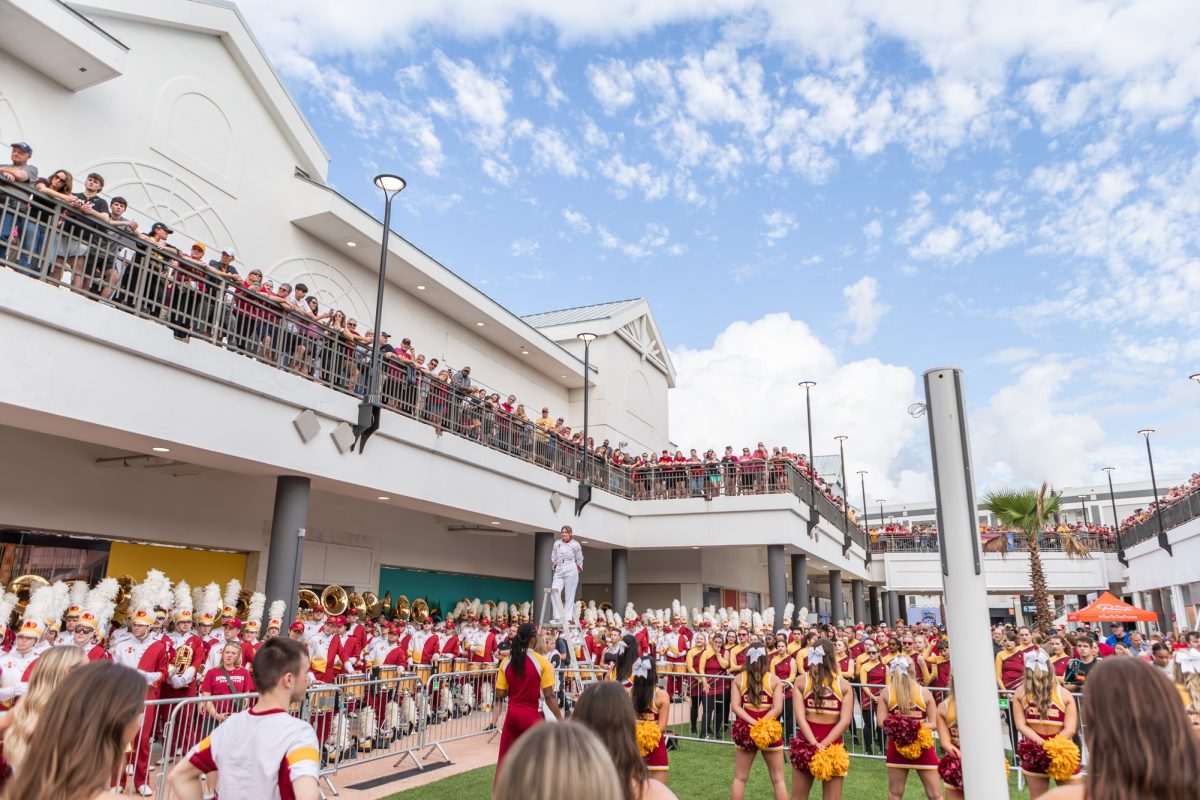Breaking barriers with English Together
Alec Giljohann/Iowa State Daily
Sonia Faiferlick, a sophomore in pre-business, moved to the United States from Lima, Peru. She attends English Together meetings to improve her English speaking skills.
February 7, 2017
In 2002, Sonia Faiferlick decided she wanted something to eat. The sandwich shop in Virginia where Faiferlick lived was a few blocks down from the house of her godmother – an easy trek, Faiferlick decided. It was when she arrived that she realized the trek may not be so easy.
“I said to [the worker,] ‘I want a sandwich,’ but my English was very poor. That was the first time when I [came] to the U.S.,” Faiferlick said.
The worker asked her what kind of bread. Here, the problem began to blossom. Faiferlick didn’t have the vocabulary to explain exactly what she wanted. Instead, she attempted to answer in an alternative way.
“With my finger, I [pointed] and I [said], ‘I want that one.’ And she told me, ‘What?!’” Faiferlick said.
As they went down the line of options, the problem began to come to fruition.
“She told me, ‘What more do you want?’” Faiferlick said.
With her finger, Faiferlick pointed to the meat.
“I [said] ‘I want that one’ with my finger again, because it was roast beef but I [didn’t] know how [to] say roast beef at that time,” Faiferlick said. “So I [pointed] with my finger. And I [said,] ‘Ese! Yo quiero ese,’ in Spanish.”
The worker didn’t understand her Spanish; Faiferlick didn’t understand her English. So, Faiferlick continued pointing.
“[And as I pointed for] the tomatoes, and for the onions, she [started] laughing about me. She called to her coworkers, and [said,] ‘Hey, look at this!’” Faiferlick said.
Faiferlick said in that moment, though she didn’t understand English, she knew they were laughing at her.
“She made me feel like I was like an animal,” Faiferlick said.
Between the glass case that separated her and the worker, Faiferlick discovered a much larger barrier: language.
English Together, an Iowa State program where native English speakers converse with non-native English speakers, is helping to eliminate those problems.
But at this time, Faiferlick wasn’t in English Together. English Together wasn’t even a program. She was only a traveler from Peru.
Faiferlick is from Barranco, a district within Lima, Peru. The district, she recalls, is made up of big houses with large doors and windows, constructed of grand, grey brick: She grew up next to the beach, where she walked each morning regardless of the weather.
Her favorite was Las Sombrillas, on the left side where it was as flat as a swimming pool. The sand was a light brown, and the sky a very light blue. Las Sombrillas is something she misses.
Four years later, Faiferlick would move to the United States with her then-husband and settle in Fort Dodge, Iowa. In the city, six years after her first visit, she would experience a similar encounter.
A Peruvian, born and raised, Faiferlick is not used to winter. She knew she had to get body lotion to counteract her dry skin, and so she headed to the mall – but not before practicing her English.
“Always, I worry […] ‘How is my English?’ So, to make sure that I [could talk to] someone, I [asked] my teacher from my [English as a Second Language (ESL)] classes,” she said.
On a piece of paper, Faiferlick asked her teacher to write down the sentences she needed to ask at the mall. Her teacher complied.
“I [repeated] and I read the sentences like, ten, twenty times… to make sure that I [had] [a] better pronunciation so they [could] understand me and [wouldn’t] have a hard time,” Faiferlick said. “I [don’t like] to give people a hard time.”
At the mall, Faiferlick would repeat the same sentence, coming from the same piece of paper which she carried with her to the mall. She asked the salesperson if she had a body lotion. The salesperson said she didn’t understand Faiferlick; Faiferlick said that she needed a body lotion. Once more, the salesperson didn’t understand her.
Faiferlick, asked to repeat herself, did so.
“The salesperson told me that she [didn’t] understand and she [walked] away from me,” Faiferlick said.
Her actions held a large impact on Faiferlick.
“I remember. That was […] very bad. So, I [left] the store, and I [got] into my car,” Faiferlick said, “and I [started] crying. Because I [felt] that person [did not] want to give me the time […] so I called my friend [and told her what was going on.]”
Her friend, an American, told Faiferlick not to move.
“She came with me to the store, and she said to the [salesperson,] ‘My friend was here. Sonia, can you repeat again what you need to buy?’ And I said, ‘I need a body lotion.’ [My friend] said to the sales girl, ‘Do you understand what she [said?]’”
The salesperson said yes. The salesperson said Faiferlick needed a body lotion.
So she gave her the body lotion.
“I [felt] so frustrated because I [felt] that she [knew] exactly what I [needed], but probably because [my first language is] Spanish […] she [didn’t] want to give me the time to listen, to hear me [and] what I [needed],” Faiferlick said.
Faiferlick, however, stayed determined.
In 2013, after three years of separation from her husband, Faiferlick earned her GED diploma. In 2014, she began her education with Iowa Central Community College. In 2016, she graduated with her associate’s degree – and in 2017, this spring serves as her first semester at Iowa State.
Because of programs such as ESL classes and Iowa State’s own program, English Together, students today may not have to face such intolerance.
Kathryn Lundgren, the program coordinator, created English Together when an ISU student came into her office and expressed the need for a conversational setting in which students could learn English.
The program began in fall 2015 and continues on today. In an hour – 5-6 p.m. Monday through Friday – conversation leaders who are native English speakers and non-native English speakers who want to improve their English gather. The environment is lax, often tables pulled together in the Pine Room of the Memorial Union.
Conversations can cover any number of things. Students come to ask how they can better order food, or ask questions about American football or even MLK Day – something Americans all know, but something that is completely foreign to students, according to Lundgren.
Because of English Together, these conversations happen.
Likewise, the conversation leaders learn all the same.
“I didn’t have much diversity in my hometown,” said Jenni Neumayer, a conversation leader and a senior in agricultural business. “Being able to come to college, there’s so much diversity. Getting to interact with [these students,] I feel like I am learning so much more about the world through them.”
Neumayer said that perhaps one of the most interesting things of being a conversation leader is the friendships made along the way.
“Just last semester, I had a [student] who came in and she was very interested in learning things about me. She didn’t want to talk about herself, she wanted to talk about me,” Neumayer said. “I thought that was really cool, that she wanted to learn about me when I was there to help her.”
It has helped Lundgren see both the similarities and differences between the cultures of the students she interacts with.
“Meeting someone who is at my age, but maybe at a completely different stage in life is always something that I’m like, ‘wow, I can do that too!’” Lundgren said.
Whether the conversations are about differences, such as radios having ‘stations’ and TVs having ‘channels,’ there is always a common core: conversation, and helping others understand English.
And all of her experiences have made Faiferlick a helper of her own.
“It’s for [my experiences] that […] when I see […] [people] that don’t understand English […] or if they need help with something […] I do [help],” Faiferlick said. “I do because I know exactly what [that feeling is] when no one wants to listen when no one’s [there] to help you.”







